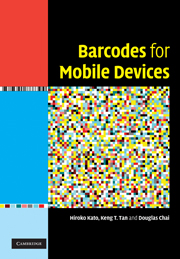Book contents
- Frontmatter
- Contents
- Preface
- 1 Introduction
- 2 Barcode technology evolution
- 3 Two-dimensional barcode for mobile phones
- 4 Evolution of barcode applications
- 5 Technologies for enhancing barcode robustness
- 6 A prototype colour 2D barcode development
- 7 Evaluation of the prototype colour 2D barcode
- Appendices
- References
- Index
- Plate section
2 - Barcode technology evolution
Published online by Cambridge University Press: 06 July 2010
- Frontmatter
- Contents
- Preface
- 1 Introduction
- 2 Barcode technology evolution
- 3 Two-dimensional barcode for mobile phones
- 4 Evolution of barcode applications
- 5 Technologies for enhancing barcode robustness
- 6 A prototype colour 2D barcode development
- 7 Evaluation of the prototype colour 2D barcode
- Appendices
- References
- Index
- Plate section
Summary
Since the first barcode system was first introduced in a Cincinnati supermarket in the United States of America (USA) 40 years ago, this technology has co-evolved together with printing and scanning techniques. The printed tags are inexpensively produced as the costs of papers and printing devices have never had a dramatic increase. This has fostered the inexpensive operation of barcode systems and, in turn, their widespread adoption. The scanning technology has also had a great impact on the development of barcode technology, as without effective scanning barcode systems cannot operate. In fact, the lack of feasible scanning systems delayed the development of early barcode systems.
Different types of barcode technology, namely, one-dimensional (1D), two-dimensional (2D) and three-dimensional (3D), have been developed to meet user needs, along with numerous barcode symbologies. Each barcode symbology has unique features to meet specific requirements. As a result, a wide variety of barcode technologies is currently available, which not only meet user needs but have become a necessity in our daily lives.
In this chapter the history of barcode technology is introduced, and this is followed by a detailed explanation of how 2D and 3D barcodes have evolved since the birth of 1D barcodes (also called linear barcodes). Next, the barcode systems and symbologies that are commonly used at present are described. Finally, we forecast how each barcode technology will progress, taking into account how their interactiveness has promoted their advancement. Furthermore, the adoption of other emerging technologies such as radio frequency identification (RFID) is also predicted.
- Type
- Chapter
- Information
- Barcodes for Mobile Devices , pp. 11 - 48Publisher: Cambridge University PressPrint publication year: 2010



